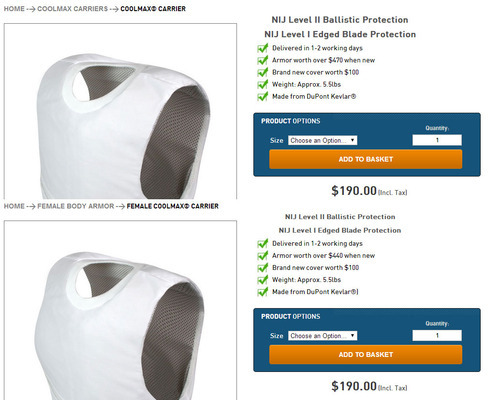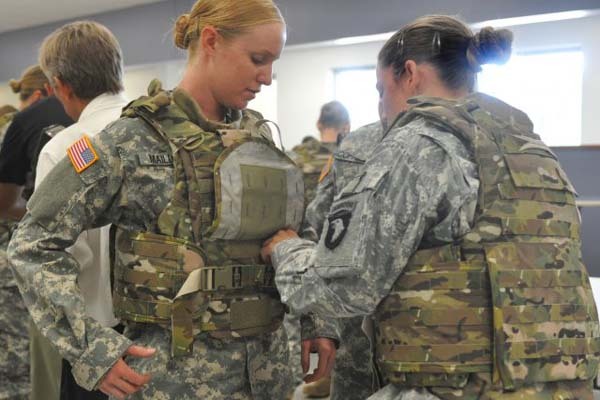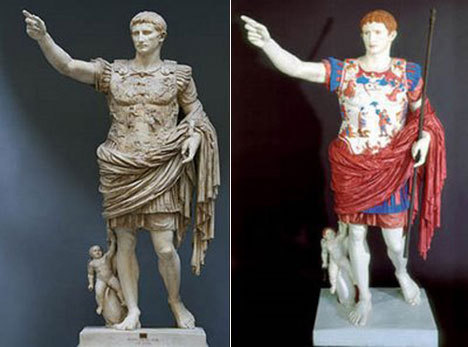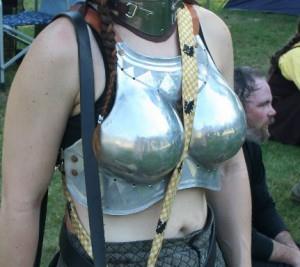Kevlar doesn’t protect as well when not having good material (basically flesh) beneath it, isn’t it bad bringing up kevlar vests when that is one of the few armors that actually should be fitted not only for women but if costs would allow it, for every person that used them?
I assume you’re referring to our tribute post to the inventor of Kevlar, Stephanie Kwolek, but no – I don’t think Kevlar vests are inherently biased against women. Certainly no more than chainmail.
It doesn’t matter what kind of armor you intend to wear – the better fitted it is to you the better it will protect you and the more efficient you will be in it.
The only way it won’t apply is if you happen to have the exact same measurements at the mannequin used in production (which doesn’t apply in the cases of things like field plate – which are always custom made). As with so many things in life, being rich is a definite advantage when it comes to armor of any sort or time period.
Guidelines for police and other parties that regularly use bullet vests recommend that the wearer not change their body mass by more than ten percent after being fitted for their vest. That means bulking up, no slimming down or putting on fat.
Many women are quite comfortable wearing even covert Kevlar armor intended for men because it just happens to fit comfortably. Many men cannot fit comfortably into a standard vest because they are not “standard” shape and size (I’m one of them).
The only difference with “female” vests is allowing space for breasts, primarily for covert body armor (that is either concealed under clothes, make to look street clothes or easily concealed with a jacket). While there is less variety in stores entry level concealed vests for women cost the same as entry level concealed vests for men.

(More information about fitting a vest here, more information on the specific alternations different companies are doing to sell armor to women here)
And again, the actual reason for different shaped armor here is not about effectiveness of stopping bullets but rather about comfort while maintaining a silhouette in order to conceal the presence of the armor -by making the wearer meet society’s expectations and fit into their regular clothes.
Actual military grade armor is not just Kevlar, but also additional features such as ceramic plates. That’s why you won’t see any boob bulges on the anti-ballistic armor worn by real female soldiers (who wear the same tactical vests as the male soldiers).

Needless to say that the people who train for very specific tasks and tend to have low amounts of body fat (and so are unlikely to be busty).
There is really no reason to think of Kevlar as an inherently problematic armor for women. There’s nothing special about the way if functions, it’s simply an awesome material for making fabric for armor out of and has been the core of modern anti-ballistic armor for decades.
Like every armor of every era, modern armor is designed around the expectations of the market – as women are becoming a larger part of that market, it is adjusting accordingly.
– wincenworks
Question: Is it possible to have armor that only serves as aesthetic quality versus functional quality only serve as that? Such as ceremonial armor or ancestral armor.
Of course. A lot of the armor that is on display in museums and owned by private collectors (and hence shown in books) was purely ornate and never intended to be worn into battle. After all, not setting foot on a battlefield does help improve the chances of your armor not being destroyed.
Prior to firearms, crossbows and other innovations making heavy armor redundant, it was commonplace for rich leaders who didn’t actually set foot on the battlefield to decorate their armor. Roman Emperors in particular seemed fond of looking absolutely fabulous in armor.

Even after heavy armor disappeared off the battlefield, many well-to-do had purely ornate suits made to try to capture the image of great heroes of years gone by. (This, and jousting armor intended only for sporting events, is part of where we get the myths of knights going to war in outfits they could barely move, let along fight in)
Ancestral armor was not really a thing in most places because generally a memorable suit of armor was part of an individual’s identity. A noble’s armor were also unlikely to fit their heirs – outside of Disney movies few families have identical measurements from generation to generation. Finally there was the issue that armor adapted as weapons did – wearing the previous generation’s armor exposed you to the current generation’s weapons.

The armor above was made for Sigismund II Augustus, the then King of Poland (who it seems probably never set foot on a battlefield) – and was one of twenty private armors owned by him at the time of his death. It would not have been unusual for a noble wearing such as suit in a parade to accessorize with a sash and/or long cape.
The important part about purely ornate armor is that it looks like armor – just with decorations that go beyond being practical. They still reflect the core armor values of the era but they’re just over decorated*, questionable accessorized and may have reductions made to facilitate their non-combat use (such as no gauntlets or arm protection if it’s for wearing to dinners and parties).
– wincenworks
* I say “over decorated” because there are some surprisingly heavily decorated suits of armor intended for real battles.
Combat vs. Reality (Plate Armor): Boob plates and swords piercing armor.
Combat vs. Reality (Plate Armor): Boob plates and swords piercing armor.
A very nice article that contrasts myths and facts about plate armor. The bit that’s most interesting for BABD is of course point 3, the one about boobplate:
Now, I know the internet has been on the buzz with blog posts crying out at about how deadly Boob plate is, but how deadly is it really? Well, the main reason you would not want to wear boob plate is that the cleavage (if you didn’t know, cleavage refers specifically to the area of separation between each breast) acts as a ‘guide’ that would force a thrusting attack directly into your armored sternum. Now, likely this isn’t as lethal as the internet would like you to believe. Swords aren’t effective against plate armor- normally. Certain weapons like the edgeless Estoc and zweilhander are tailor made for thrusting and piercing into plate armor. Coincidentally these weapons existed at their peak in the 15th and 16th century – the period with the heaviest armored soldiers. But please remember, plate armor would not have lasted as long as it did if it was not effective.
Your average longsword though isn’t going to penetrate armor because it doesn’t just have to get through the plate. A plate wearing warrior starts dressing for battle by putting on his or her gambeson. This was a fairly heavy jacket commonly made with cotton and was somewhere around a half inch thick. With roughly 20-40 layers of cotton these were known to stop heavy arrows by themselves. They were in sense the middle ages ballistics vest. Then the warrior would don a mail shirt – and those of the highest quality would be as fluid as a silk shirt while also being impenetrable to a needle. These alone would stop sword cuts and small projectiles. THEN the warrior donned his plates that covered the underarmor. These alone can stop most sword thrusts and all sword blows. Combined these defenses would make it impossible to use a sword against a plate wearer if it wasn’t an estoc or zweilhander. Those only being successful due to their narrow blade that was designed to exploit the small gaps and unions between separate plates.
So then boob plate wouldn’t reallybe that fatal. It however certainly does not increase your chances of living and should be avoided just to reduce your chances of impalement. Another argument all these blog posts seem to be picking from the same source is that boob plate would break your sternum if you fell flat on it and accompanied with it is this picture:
Ok, in this severe of a case without a gambeson or mail underneath and with a fairly large bust size that would break your sternum if you fell on it. But, boob plate is even common in the SCA and I have seen people fall flat on their faces – the bruises left by the weapons are far bigger than those left by armor. They were were however wearing a breastplate with shallow curves and clothing underneath – much like a woman in the middle ages would’ve. Note also that the SCA forbids armor with separated breast cups, meaning that any boob formed plates need to be formed directly into the breastplate.
So what’s the real reason armor shouldn’t have boob plates? Simply put it’s because we have zero historical examples of it, and it’s not for any of the reasons listed in the article. They are all modern theories made by modern minds with more knowledge of the internet than of armor. Think about it from the mind of a blacksmith. Or a bullet proof vest maker. Do we make bullet proof vest custom made for women? No, because a properly fitted bullet proof vest is comfortable to wear and it would be silly to make it anymore body hugging. The same holds true with armor. A custom tailored breastplate made for a women will be just as comfortable as if it were boob plate. There is absolutely no benefit in creating those awkward curves in the armor with primitive tools. It would’ve been extra work for no gain. Plus, a woman already looks much more androgynous after she’s put on her gambeson and mail coat. The defining characteristic of a female suit of armor is the torso…it’s often narrower and occasionally it will be “corseted” mimicking the hourglass shape of the woman that wore it. These examples of female armor though are extremely rare, in fact we only have a handful of surviving suits today that we can at best guess assume were tailored for women.
Bolding mine.
Thanks to tehkail for directing us at this post in their reblog.
~Ozzie








































